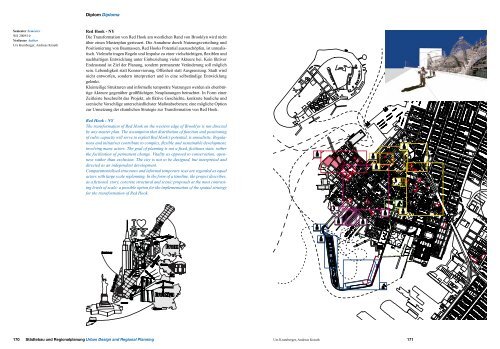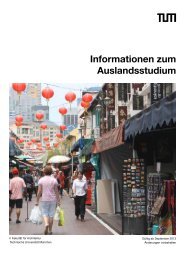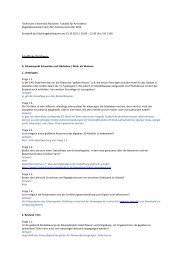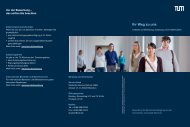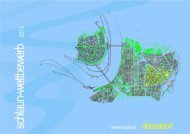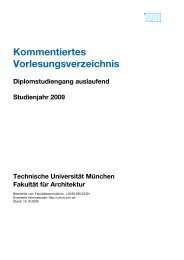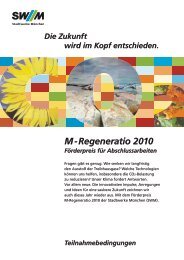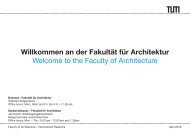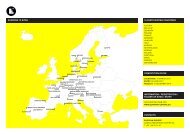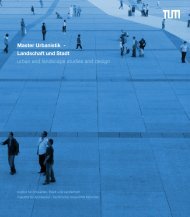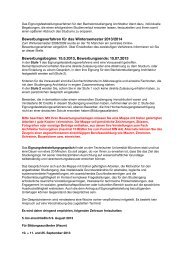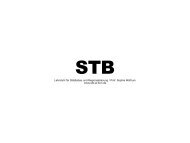Institute Institutes - Fakultät für Architektur - TUM
Institute Institutes - Fakultät für Architektur - TUM
Institute Institutes - Fakultät für Architektur - TUM
Sie wollen auch ein ePaper? Erhöhen Sie die Reichweite Ihrer Titel.
YUMPU macht aus Druck-PDFs automatisch weboptimierte ePaper, die Google liebt.
Semester Semester<br />
WS 2009/10<br />
Verfasser Author<br />
Urs Kumberger, Andreas Krauth<br />
Diplom Diploma<br />
Red Hook - NY<br />
Die Transformation von Red Hook am westlichen Rand von Brooklyn wird nicht<br />
über einen Masterplan gesteuert. Die Annahme durch Nutzungsverteilung und<br />
Positionierung von Baumassen, Red Hooks Potential auszuschöpfen, ist unrealistisch.<br />
Vielmehr tragen Regeln und Impulse zu einer vielschichtigen, flexiblen und<br />
nachhaltigen Entwicklung unter Einbeziehung vieler Akteure bei. Kein fiktiver<br />
Endzustand ist Ziel der Planung, sondern permanente Veränderung soll möglich<br />
sein. Lebendigkeit statt Konservierung, Offenheit statt Ausgrenzung. Stadt wird<br />
nicht entworfen, sondern interpretiert und in eine selbständige Entwicklung<br />
gelenkt.<br />
Kleinteilige Strukturen und informelle temporäre Nutzungen werden als ebenbürtige<br />
Akteure gegenüber großflächigen Neuplanungen betrachtet. In Form einer<br />
Zeitleiste beschreibt das Projekt, als fiktive Geschichte, konkrete bauliche und<br />
szenische Vorschläge unterschiedlichster Maßstabsebenen; eine mögliche Option<br />
zur Umsetzung der räumlichen Strategie zur Transformation von Red Hook.<br />
Red Hook - NY<br />
The transformation of Red Hook on the western edge of Brooklyn is not directed<br />
by any master plan. The assumption that distribution of function and positioning<br />
of cubic capacity will serve to exploit Red Hook’s potential, is unrealistic. Regulations<br />
and initiatives contribute to complex, flexible and sustainable development,<br />
involving many actors. The goal of planning is not a fixed, fictitious state, rather<br />
the facilitation of permanent change. Vitality as opposed to conservation, openness<br />
rather than exclusion. The city is not to be designed, but interpreted and<br />
directed as an independent development.<br />
Compartmentalised structures and informal temporary uses are regarded as equal<br />
actors with large scale replanning. In the form of a timeline, the project describes,<br />
as a fictional story, concrete structural and scenic proposals at the most contrasting<br />
levels of scale; a possible option for the implementation of the spatial strategy<br />
for the transformation of Red Hook.<br />
Staten Island<br />
Ellis Island<br />
Williamsburg Bridge<br />
Brooklyn<br />
Coney Island<br />
Queens<br />
JFK<br />
170 Städtebau und Regionalplanung Urban Design and Regional Planning<br />
Urs Krumberger, Andreas Krauth<br />
171<br />
Reed St<br />
Ferris St<br />
Conover St<br />
Beard St<br />
Van Dyke St<br />
Van Brunt Ave<br />
Co�ey St<br />
Dikeman St<br />
Wolcott St<br />
Richards St<br />
Sullivan St<br />
King St<br />
Pioneer St<br />
Dwight St<br />
Visitation Pl<br />
Otsego St<br />
Imlay St<br />
Verona St<br />
Delewan St<br />
Commerce St<br />
Seabring St<br />
Bowne St<br />
Columbia Ave<br />
W 9th St<br />
Nelson St<br />
Luquer St<br />
Hicks St<br />
Henry St<br />
Mill St<br />
Center Mall<br />
Clinton St<br />
Halleck St<br />
Creamer St<br />
Bay St<br />
Lorraine St<br />
Court St<br />
Sirgourney St<br />
Smith St


